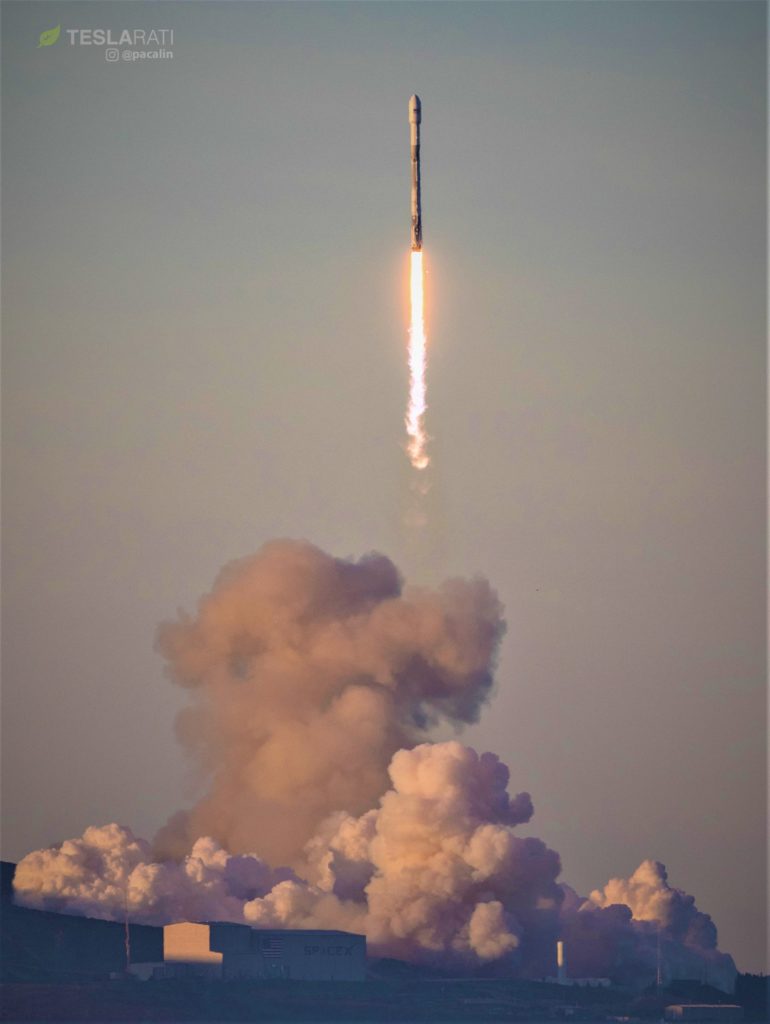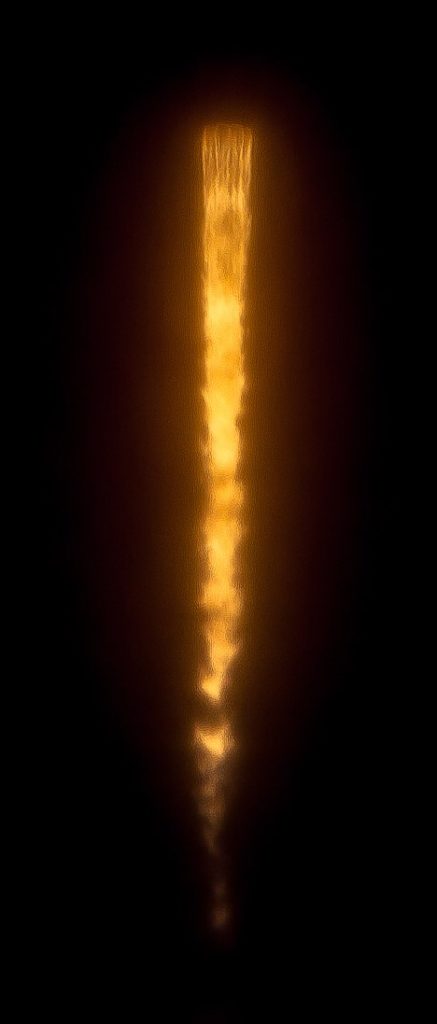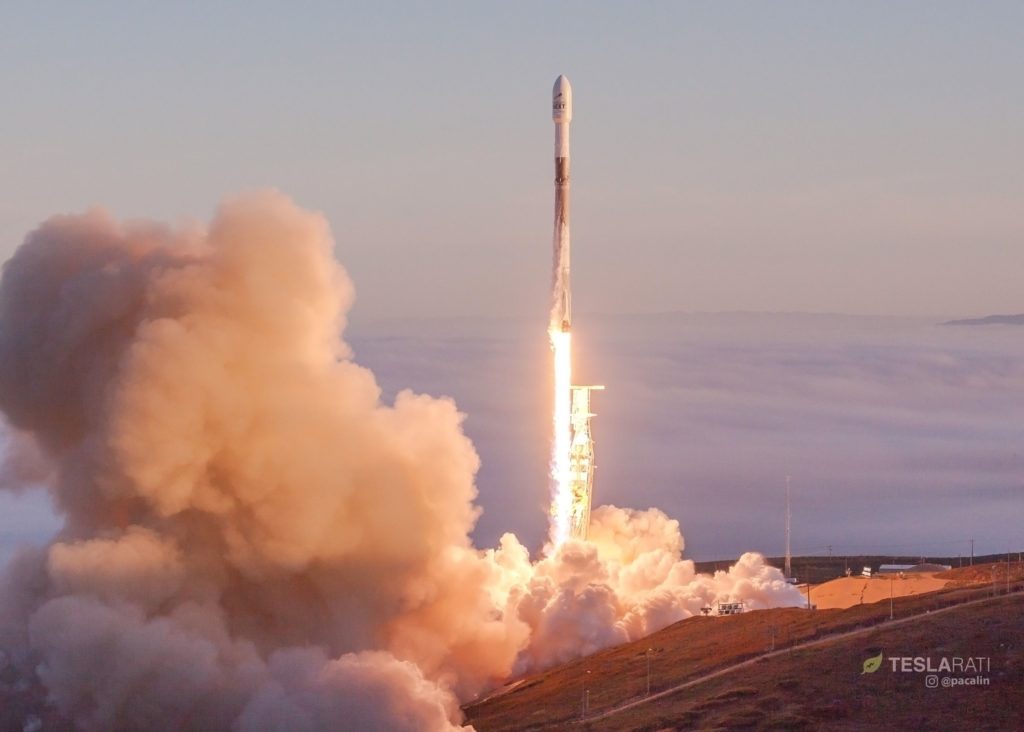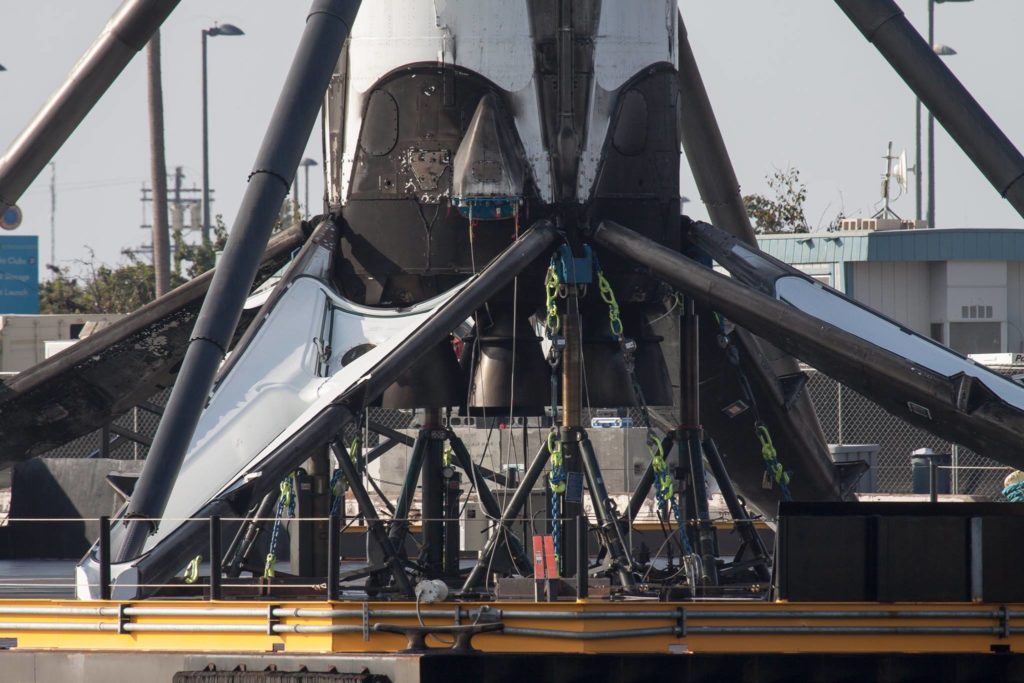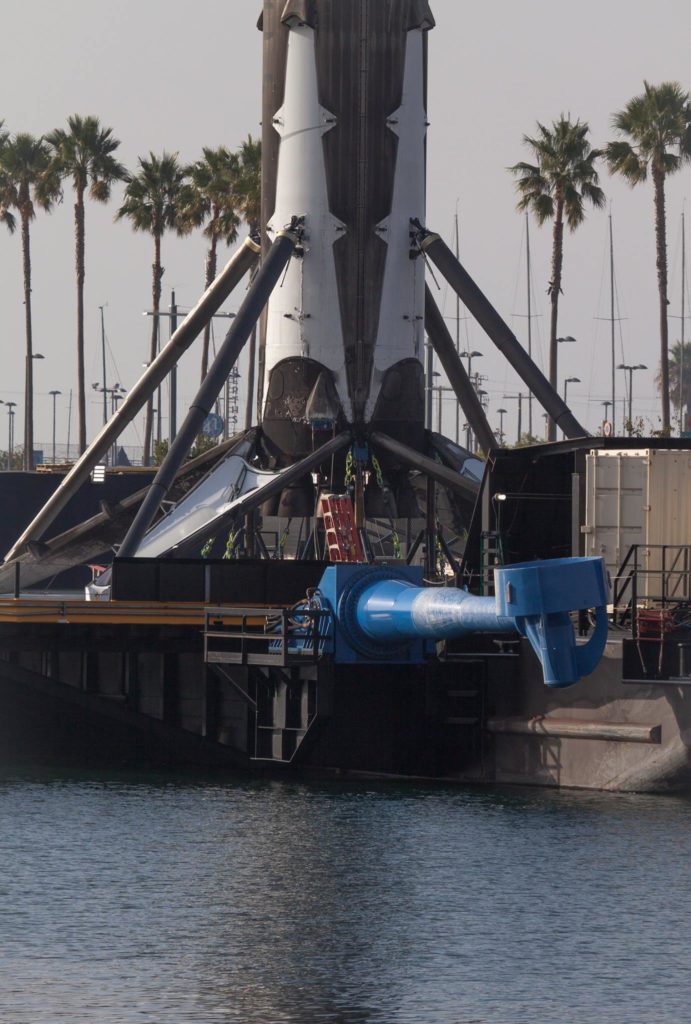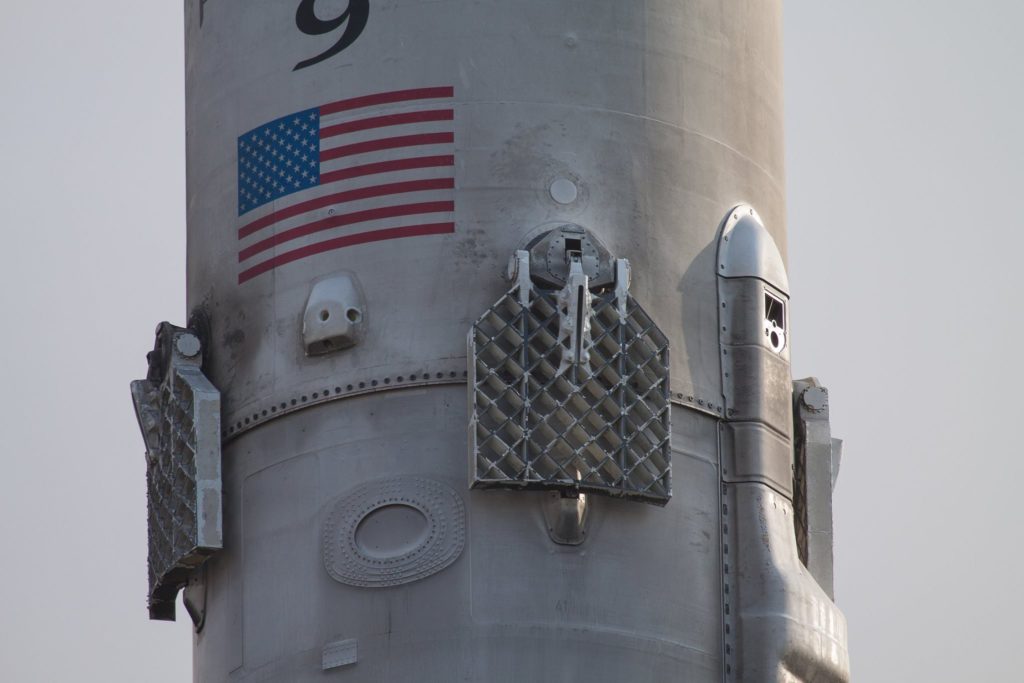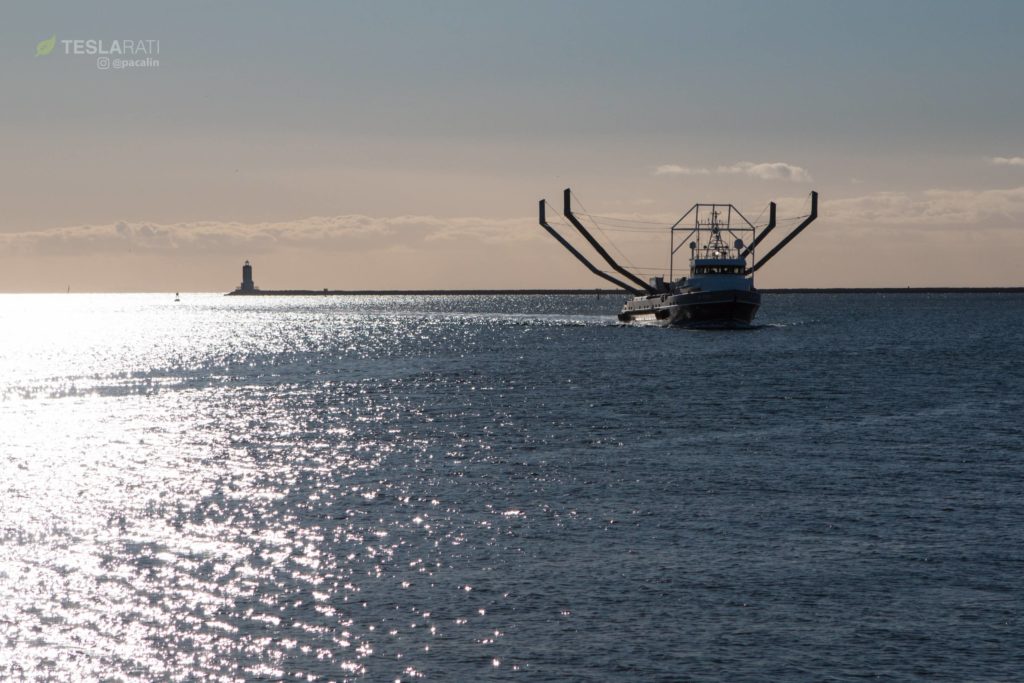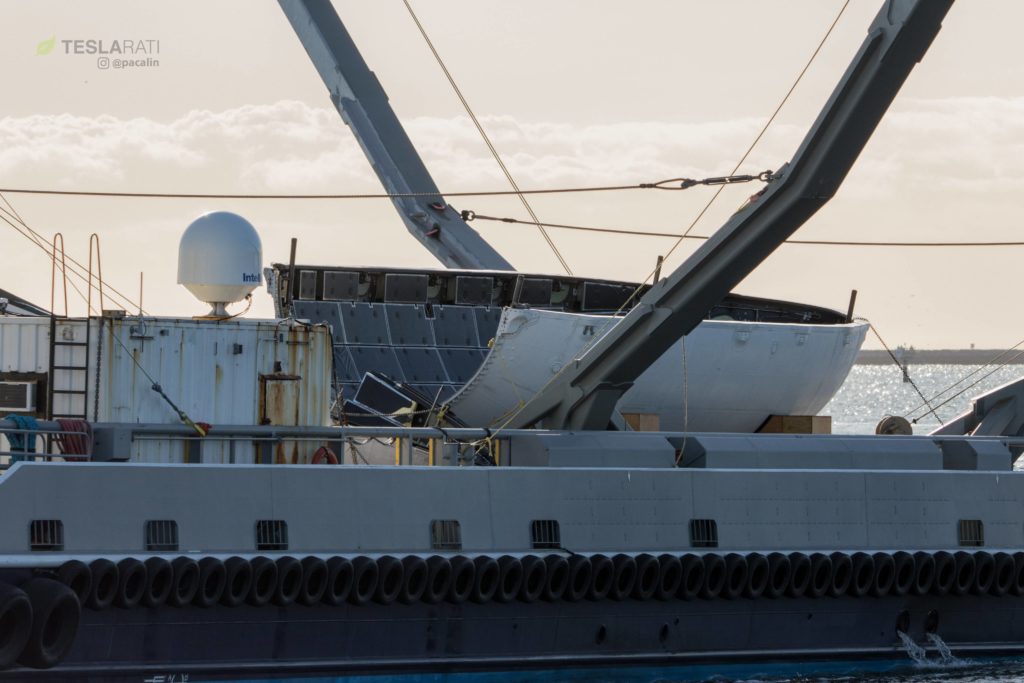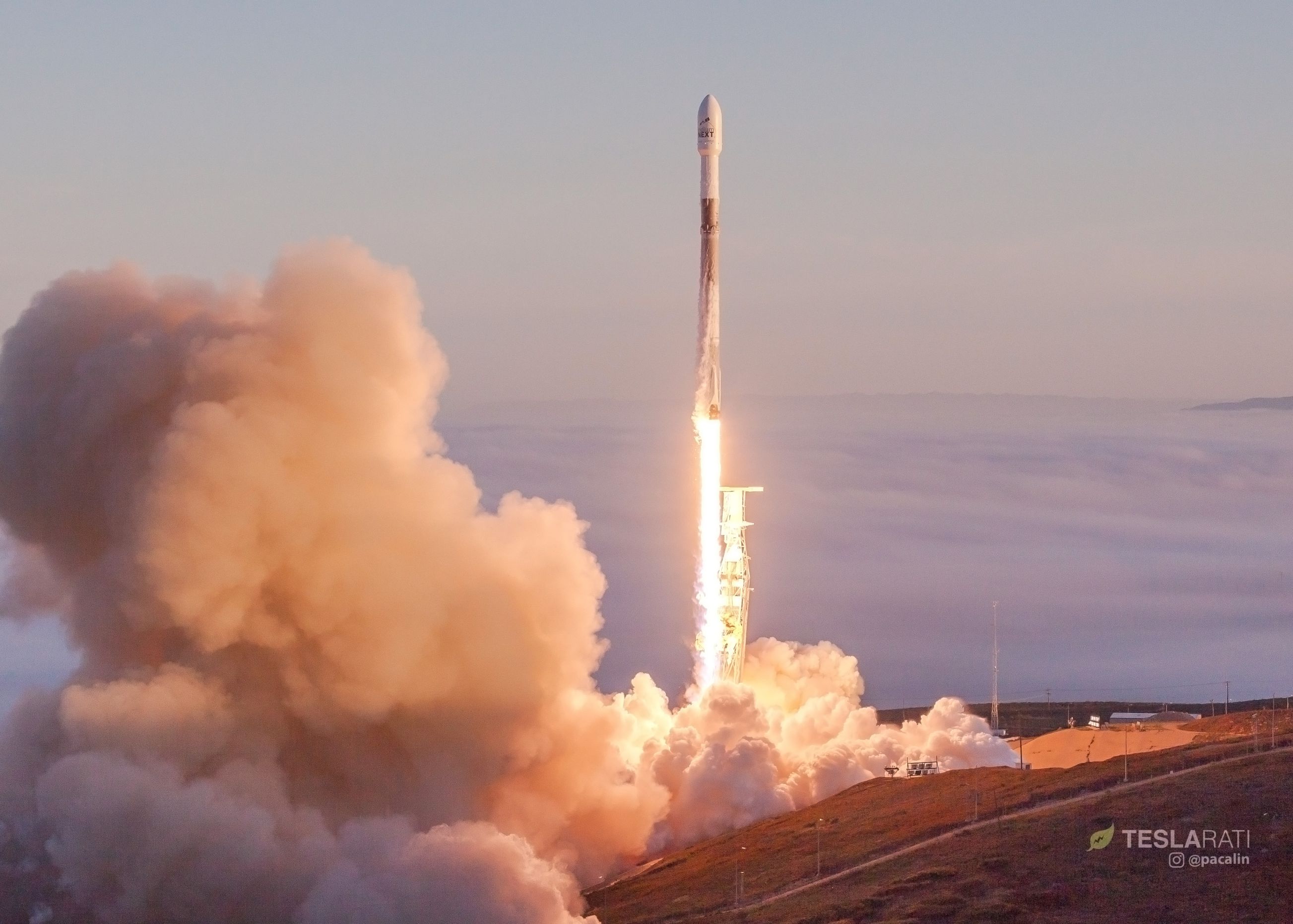

News
SpaceX pushes boundaries of fairing recovery with breathtaking sunrise launch [photos]
SpaceX has soared past the halfway point of completion for Iridium’s next-generation NEXT constellation with the successful launch of satellites 41-50 earlier this morning. SpaceX has three additional launches contracted with Iridium for a total of eight. Despite intentionally ditching the flight-proven first stage booster in the Pacific Ocean, SpaceX attempted to recover one half of the payload fairing; an effort acknowledged to be predominately experimental at this point.
- F9 B1041 gives one final swan song with the successful launch of 10 more Iridium NEXT satellites. (Pauline Acalin)
- Although fog and camera difficulties slightly marred the shot, note the details in Falcon 9’s normally white-hot exhaust. (Pauline Acalin)
- Falcon 9 1041 rises above a sea of fog for one last mission to orbit. Half of its fairing made a surprise appearance in port on Saturday. (Pauline Acalin)
Iridium-5 continues a recent trend of monthly launches out of SpaceX’s Vandenberg Air Force Base launch facilities – the company’s SLC-4E pad is known to take a bit longer than its East coast brethren for refurbishment and repairs between launches, typically maxing out approximately one launch per month. This launch also marks another flight-proven booster intentionally expended, likely in part because the West Coast drone ship Just Read The Instructions is currently out of commission, awaiting the delivery of critical subsystems stripped to repair the Eastern OCISLY.
As of posting, all 10 Iridium NEXT satellites have been successfully deployed into low Earth orbit, marking the successful completion of this mission. On the recovery side of the mission, SpaceX CEO Elon Musk had initially teased Mr Steven’s upcoming fairing catch attempt – his silence since providing a T-0 around 7:44 am PST presumably speaks to the experimental nature of these fairing recovery efforts, and hints that this attempt may not have been successful.
GPS guided parafoil twisted, so fairing impacted water at high speed. Air wake from fairing messing w parafoil steering. Doing helo drop tests in next few weeks to solve.
— Elon Musk (@elonmusk) March 30, 2018
A couple hours after launch, Musk took to Twitter to confirm that this fairing recovery effort had failed, largely due to the complexity of safely parafoiling such a large, fast, and ungainly object. “[Helicopter] drop tests” are planned for coming weeks in order to put to bed the problems ailing fairing recovery. As SpaceX announcer and materials engineer Michael Hammersley noted, “the ultimate goal is full recovery and reuse of the entire vehicle,” and experimental fairing recovery efforts push SpaceX one step closer to that ambition.
- F9 B1041 arrives in port after its first successful mission, Iridium-3, in October 2017. (Pauline Acalin)
- 1041 flew for its second and final time earlier this morning, sans any landing aboard JRTI. (Pauline Acalin)
- B1041 presumably soft-landed in the Pacific, as did its fairing. (Pauline Acalin)
- RIP. (Pauline Acalin)
Space (regulation) oddity
Perhaps the most unusual feature of this launch was an announcement soon after the webcast began that NOAA (the National Ocean and Atmospheric Administration) apparently restricted SpaceX’s ability to provide live coverage of Falcon 9’s upper stage once in orbit, and the webcast thus ended moments after the second stage Merlin Vacuum engine shut off. By all appearances, this is fairly unprecedented: NOAA is tasked with “licensing…operations of private space-based remote sensing systems” with their Commercial Remote Sensing Regulatory Affairs (CRSRA) branch, but they’ve been quite inept and heavy-handed in their implementation of Earth imaging regulation. Nominally, the purpose of that regulation is to protect sensitive US security facilities and activities from the unblinking eyes of private, orbital imaging satellites, but NOAA has quite transparently exploited its power in ways that create extreme uncertainty and near-insurmountable barriers to entry for prospective commercial Earth-imaging enterprises.
What an absolutely beautiful launch at Vandenberg this morning. Congratulations to SpaceX on another successful mission accomplished! #SpaceX #Iridium5 @Teslarati pic.twitter.com/hsp7H5bv8J
— Pauline Acalin (@w00ki33) March 30, 2018
Presumably, this protects their (and their prime contractors’) vested interest in NOAA’s continuing quasi-monopoly over Earth sciences and weather-related satellite production and operations, a segment of the agency’s budget known to aggressively devour as much of NOAA’s budget as practicable. In this sense, something as arbitrary as preventing a launch provider like SpaceX from showing live, low-resolution (functionally useless) video feeds from orbit would be thoroughly disappointing, but in no way surprising. In this case, the restriction is comically transparent in its blatant inconsistency: SpaceX has flown more than 50 launches over more than a decade, all of which featured some form of live coverage of the upper stage once in orbit, and none of which NOAA objected to. Fingers crossed that this absurd restriction can be lifted sooner than later.
- No fairing snack for Mr Steven this time around. (Pauline Acalin)
- PAZ’s recovered fairing half sadly cracked beyond repair while being hauled aboard Mr Steven. (Pauline Acalin)
Follow us for live updates, behind-the-scenes sneak peeks, and a sea of beautiful photos from our East and West coast photographers.
Teslarati – Instagram – Twitter
Tom Cross – Twitter
Pauline Acalin – Twitter
Eric Ralph – Twitter
News
SpaceX’s Crew-11 mission targets July 31 launch amid tight ISS schedule
The flight will lift off from Launch Complex 39A at Kennedy Space Center in Florida.

NASA and SpaceX are targeting July 31 for the launch of Crew-11, the next crewed mission to the International Space Station (ISS). The flight will lift off from Launch Complex 39A at Kennedy Space Center in Florida, using the Crew Dragon Endeavour and a Falcon 9 booster.
Crew Dragon Endeavour returns
Crew-11 will be the sixth flight for Endeavour, making it SpaceX’s most experienced crew vehicle to date. According to SpaceX’s director of Dragon mission management, Sarah Walker, Endeavour has already carried 18 astronauts representing eight countries since its first mission with NASA’s Bob Behnken and Doug Hurley in 2020, as noted in an MSN report.
“This Dragon spacecraft has successfully flown 18 crew members representing eight countries to space already, starting with (NASA astronauts) Bob (Behnken) and Doug (Hurley) in 2020, when it returned human spaceflight capabilities to the United States for the first time since the shuttle retired in July of 2011,” Walker said.
For this mission, Endeavour will debut SpaceX’s upgraded drogue 3.1 parachutes, designed to further enhance reentry safety. The parachutes are part of SpaceX’s ongoing improvements to its human-rated spacecraft, and Crew-11 will serve as their first operational test.
The Falcon 9 booster supporting this launch is core B1094, which has launched in two previous Starlink missions, as well as the private Ax-4 mission on June 25, as noted in a Space.com report.
The four-members of Crew-11 are NASA astronauts Zena Cardman and Mike Fincke, as well as Japan’s Kimiya Yui and Russia’s Oleg Platonov.
Tight launch timing
Crew-11 is slated to arrive at the ISS just as NASA coordinates a sequence of missions, including the departure of Crew-10 and the arrival of SpaceX’s CRS-33 mission. NASA’s Bill Spetch emphasized the need for careful planning amid limited launch resources, noting the importance of maintaining station altitude and resupply cadence.
“Providing multiple methods for us to maintain the station altitude is critically important as we continue to operate and get the most use out of our limited launch resources that we do have. We’re really looking forward to demonstrating that capability with (CRS-33) showing up after we get through the Crew-11 and Crew-10 handover,” Spetch stated.
Lifestyle
EV fans urge Tesla to acquire Unplugged Performance for edge in fleet and security industry
Unplugged Performance has built a name for itself by producing performance upgrades for Tesla vehicles.

A growing number of Tesla enthusiasts and longtime community voices are calling on the electric vehicle maker to acquire Unplugged Performance, a California-based aftermarket company best known for tuning Tesla vehicles and developing specialized government fleet solutions under its UP.FIT division.
The idea was once considered a niche proposal among EV fans, but it is now gaining serious attention not just as a performance play but as a strategic move to deepen Tesla’s roots in the fleet and security industry.
A strategic fit
Unplugged Performance has built a name for itself by producing performance upgrades for Tesla vehicles, from track-optimized components to visual and aerodynamic upgrades. But in recent years, its UP.FIT division has pivoted toward a more functional future by outfitting Tesla vehicles like Model Ys for police, military, and government use.
That work has sparked growing calls for closer collaboration with Tesla, especially as the EV maker increasingly leans into autonomy, AI, and fleet services as core components of its next chapter.
“I posted this four years ago, but I think it’s more true now than ever,” wrote Whole Mars Catalog, a well-known Tesla investor and FSD Beta tester, on X. “Tesla should buy Unplugged. But not just as a Performance division. What they are doing with UP.FIT unlocks large government and commercial fleet purchases that can improve utilization.”
Tesla fans such as shareholder Sawyer Merritt echoed the sentiment, calling Unplugged a “great fit within Tesla.” adding, “They are literally located directly next to Tesla’s design studio in Hawthorne.”
Enabling the next wave
Supporters of the idea noted that integrating Unplugged into Tesla’s corporate structure could help accelerate the adoption of autonomous technologies in government sectors. With UP.FIT patrol cars already in use across some U.S. police departments, Tesla fans envisioned a future where self-driving Teslas could potentially revolutionize law enforcement, search-and-rescue, and public service logistics.
“Just imagine how autonomous patrol cars could transform policing and bring us into a safer future,” the veteran FSD tester wrote.
The benefits could also extend to Tesla’s existing consumer base. “They also have some incredible products in the works that I think will appeal to many ordinary Tesla drivers — not just those looking for performance or mods. Stuff that’s so good it should have come straight from the design studio next door,” Whole Mars Catalog noted.
Unplugged Performance, founded in 2013, shares not just a product vision with Tesla, but also geography. Its Hawthorne headquarters sits directly adjacent to Tesla’s design studio, and the two companies have maintained a close working relationship over the years. The aftermarket firm has long positioned itself as a “mission-aligned” partner to Tesla.
In response to the recent calls for acquisition, Unplugged Performance acknowledged the support from the community. “Our very existence is to support the Tesla mission with @UpfitTesla and @UnpluggedTesla,” Unplugged CEO Ben Schaffer posted on X. “We love working with Tesla and are grateful for the community’s support since 2013!”
News
Tesla debuts hands-free Grok AI with update 2025.26: What you need to know
All new Tesla vehicles delivered on or after July 12, 2025, will include Grok AI out of the box

Tesla has begun rolling out Grok, an in-car conversational AI assistant developed by xAI, to eligible vehicles starting July 12. The feature marks the most direct integration yet between Elon Musk’s artificial intelligence startup and Tesla’s consumer product lineup, offering drivers hands-free access to a chat-style companion while on the road.
Grok comes pre-installed on new vehicles
According to Tesla’s FAQ page for the feature, all new vehicles delivered on or after July 12, 2025, will include Grok AI out of the box. Owners of older vehicles may gain access through an over-the-air update, provided their vehicle meets a few hardware and software requirements.
Specifically, Grok is currently only supported on Tesla models equipped with an AMD infotainment processor and running vehicle software version 2025.26 and higher. Compatible models include the Model S, Model 3, Model X, Model Y, and Cybertruck. A Premium Connectivity subscription or active Wi-Fi connection is also required.
Tesla notes that additional vehicle compatibility may arrive in future software updates.
Grok’s features and limitations for now
Drivers can engage with Grok using the App Launcher or by pressing and holding the voice command button on the steering wheel. Grok is designed to answer questions and hold conversations using natural language, offering responses tailored to its chosen personality—ranging from “Storyteller” to the more eccentric “Unhinged.”
For fun, Tesla posted a demonstration of Grok likely running on “Unhinged” talking about what it would do to Optimus when they are on a date, much to the shock of the humanoid robot’s official social media account.
It should be noted, however, that Grok cannot currently issue commands to the vehicle itself, at least for now. Traditional voice commands for tasks like climate control, navigation, or media remain separate from Grok as of writing.
The feature is being released in Beta and does not require a Grok account or xAI subscription to activate, although that policy may change over time.
Grok privacy and in-car experience
Tesla emphasizes that interactions with Grok are securely processed by xAI and not linked to a user’s Tesla account or vehicle. Conversations remain anonymous unless a user signs into Grok separately to sync their history across devices.
Tesla has also begun promoting Grok directly on its official vehicle webpages, showcasing the feature as part of its in-car experience, further highlighting the company’s increasing focus on AI and infotainment features on its all-electric vehicles.
-

 Elon Musk2 weeks ago
Elon Musk2 weeks agoTesla investors will be shocked by Jim Cramer’s latest assessment
-

 Elon Musk2 days ago
Elon Musk2 days agoxAI launches Grok 4 with new $300/month SuperGrok Heavy subscription
-

 Elon Musk5 days ago
Elon Musk5 days agoElon Musk confirms Grok 4 launch on July 9 with livestream event
-

 News1 week ago
News1 week agoTesla Model 3 ranks as the safest new car in Europe for 2025, per Euro NCAP tests
-

 Elon Musk1 week ago
Elon Musk1 week agoxAI’s Memphis data center receives air permit despite community criticism
-

 News2 weeks ago
News2 weeks agoXiaomi CEO congratulates Tesla on first FSD delivery: “We have to continue learning!”
-

 News2 weeks ago
News2 weeks agoTesla sees explosive sales growth in UK, Spain, and Netherlands in June
-

 Elon Musk2 weeks ago
Elon Musk2 weeks agoTesla scrambles after Musk sidekick exit, CEO takes over sales

